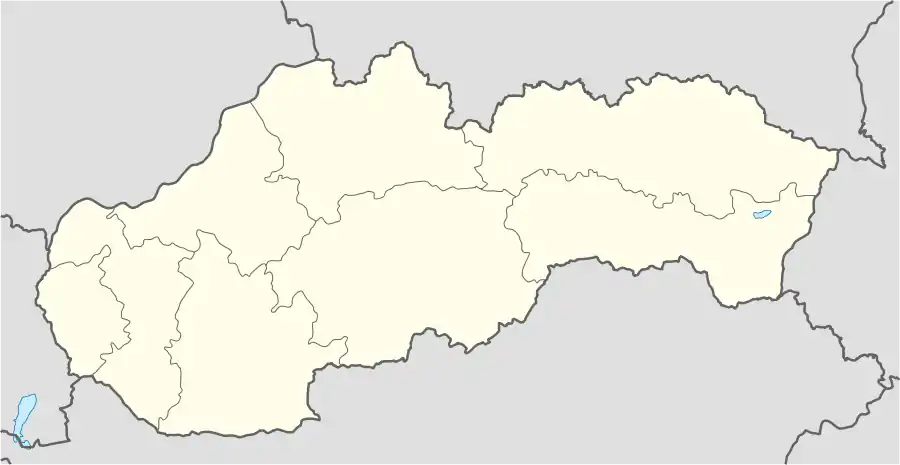Zlaté Moravce
Zlaté Moravce (Slovak pronunciation: [ˈzlatɛː ˈmɔɾaʊ̯tsɛ]; 1776 Morawce, Hungarian: Aranyosmarót, German: Goldmorawitz) is a town in south-western Slovakia.
Zlaté Moravce | |
|---|---|
Town | |
.jpg.webp) View of the town center | |
 Flag | |
 Zlaté Moravce Location of Zlaté Moravce in Slovakia | |
| Coordinates: 48°22′42″N 18°23′48″E | |
| Country | Slovakia |
| Region | Nitra |
| District | Zlaté Moravce |
| First mentioned | 1113 |
| Government | |
| • Mayor | Dušan Husár |
| Area | |
| • Total | 27.15 km2 (10.48 sq mi) |
| Elevation | 196 m (643 ft) |
| Population (2018-12-31[1]) | |
| • Total | 11,465 |
| • Density | 420/km2 (1,100/sq mi) |
| Time zone | UTC+1 (CET) |
| • Summer (DST) | UTC+2 (CEST) |
| Postal code | 953 01 |
| Area code(s) | +421-37 |
| Car plate | ZM |
| Website | www.zlatemoravce.eu |
Basic data
It is the capital and the biggest town of Zlaté Moravce District. It is approximately 120 km from the Slovak capital Bratislava and 32 km from Nitra.
History
The town is situated on the banks of the river Žitava, in the northern part of the Podunajská Heights. Nowadays, it also includes the area of formerly separate boroughs Chyzerovce and Prílepy. Thanks to its favourable location on the natural terrace of the river Žitava, the traces of the continuous settlement of this area go back to the Paleolithic Age. The rich archeological findings in the town area also prove intensive Great Moravian settlement in the 9th-10th century. A unique finding – a golden pectoral cross – is associated with this settlement.
The origin of the oldest name of the borough "Morowa" in the Charter of Zobor of 1113 is related to that time as well. This charter is the oldest written proof of the existence of Moravce as Zobor Monastery's property. The borough that was situated on the important route to Tekov was already in the 13th century dominated by a small Roman church surrounded by a cemetery, which was located on the site of today's square.
The first written mentions of the town are from 12th century A.D. (1113 Morowa, 1284 Marouth). "Moravce" [pronounced app. Moravtseh], a word in plural, was a frequent settlement name in Slovakia and means "settlement of (the tribe) Moravians". The attribute "zlaté", meaning "golden", was added only later in order to distinguish the settlement's name from all the other "Moravce"s. Ottomans plundered the city in 1530 and 1573.
Rivers (Žitava, Zlatnanka) in the surrounding areas were known in the past for gold washing. Note the name of the second river. In the Slavic languages Zlato means gold.
Demographics
According to the 2001 census, the town had 15,618 inhabitants. 97.09% of inhabitants were Slovaks, 0.60% Czechs and 0.29% Hungarians.[2] The religious makeup was 82.52% Roman Catholics, 10.59% people with no religious affiliation and 1.48% Lutherans.[2] An active Jewish community had existed here until the Holocaust. Zlaté Moravce has a town status from 1960.
Industry
The town is known for the production of kitchen technologies (well known as a brand CALEX which is actually not existing in the present) and building materials - bricks.
Historical monuments
- WWI and WWII victims
- Holocaust victims from Zlaté Moravce memorial
Notable people
- Janko Kráľ, a poet of Slovak Romanticism
- Ján Kocian, footballer, football trainer
- Tono Stano, photographer
Twin towns — sister cities
References
- "Population and migration". Statistical Office of the Slovak Republic. Retrieved 2019-04-16.
- "Municipal Statistics". Statistical Office of the Slovak republic. Archived from the original on 2008-01-11. Retrieved 2008-01-13.
- "Partnerské mestá". zlatemoravce.eu (in Slovak). Zlaté Moravce. Retrieved 2019-09-08.